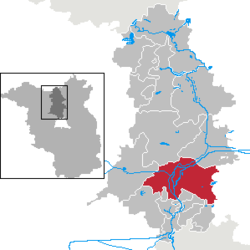Oranienburg
| Oranienburg | ||
|---|---|---|

|
||
|
||
| Coordinates: 52°45′16″N 13°14′13″E / 52.75444°N 13.23694°ECoordinates: 52°45′16″N 13°14′13″E / 52.75444°N 13.23694°E | ||
| Country | Germany | |
| State | Brandenburg | |
| District | Oberhavel | |
| Government | ||
| • Mayor | Hans-Joachim Laesicke (SPD) | |
| Area | ||
| • Total | 162.37 km2 (62.69 sq mi) | |
| Elevation | 34 m (112 ft) | |
| Population (2015-12-31) | ||
| • Total | 43,526 | |
| • Density | 270/km2 (690/sq mi) | |
| Time zone | CET/CEST (UTC+1/+2) | |
| Postal codes | 16515 | |
| Dialling codes | 03301 | |
| Vehicle registration | OHV | |
| Website | www.oranienburg.de | |
Oranienburg is a town in Brandenburg, Germany. It is the capital of the district of Oberhavel.
Oranienburg is a town located on the banks of the Havel river, 35 km north of the centre of Berlin.
Oranienburg consists of 9 districts
Originally named Bötzow, the town of Oranienburg dates from the 12th century and was first mentioned in 1216. Margrave Albert the Bear (ruled 1157-1170) allegedly ordered the construction of a castle on the banks of the Havel. Around the castle stood a settlement of traders and craftsmen.
In 1646 Friedrich Wilhelm I of Brandenburg married Louise Henriette of Orange-Nassau (German: Oranien-Nassau). She was so attracted by the town of Bötzow that her husband presented the entire region to her. The princess ordered the construction of a new castle in the Dutch style and called it Oranienburg or Schloss Oranienburg. In 1653 the town of Bötzow was renamed Oranienburg.
Silvio Gesell, the founder of Freiwirtschaft ("free economy"), lived in Oranienburg between 1911 and 1915, publishing his magazine, Der Physiocrat. He returned to the town in 1927 and lived there until his death in 1930. The town remained a center of the "free economy" movement until the Nazi régime outlawed it in 1933, and many of Gesell's followers ended up as prisoners in the town's concentration camp.
The Oranienburg concentration camp (established in March 1933) was one of the first Nazi concentration camps. In 1936 the Sachsenhausen concentration camp on the outskirts of Oranienburg replaced it; there 200,000 people were interned over the 9 years that the Nazis operated it. The Nazis murdered about 22,000 people there before the liberation of the camp by the Soviet Red Army in 1945. Thereafter the site reopened in August 1945 as "Soviet Special Camp 7". A further 12,000 people (mostly Nazis not awaiting trial) died under the Soviets before the Special Camp closed in 1950. Their remains were not discovered until the 1990s.
...
Wikipedia



